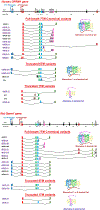Dysregulated expression of the alternatively spliced variant mRNAs of the mu opioid receptor gene, OPRM1, in the medial prefrontal cortex of male human heroin abusers and heroin self-administering male rats
- PMID: 32506472
- PMCID: PMC8143898
- DOI: 10.1002/jnr.24640
Dysregulated expression of the alternatively spliced variant mRNAs of the mu opioid receptor gene, OPRM1, in the medial prefrontal cortex of male human heroin abusers and heroin self-administering male rats
Abstract
Heroin, a mu agonist, acts through the mu opioid receptor. The mu opioid receptor gene, OPRM1, undergoes extensive alternative splicing, creating an array of splice variants that are conserved from rodent to humans. Increasing evidence suggests that these OPRM1 splice variants are pharmacologically important in mediating various actions of mu opioids, including analgesia, tolerance, physical dependence, rewarding behavior, as well as addiction. In the present study, we examine expression of the OPRM1 splice variant mRNAs in the medial prefrontal cortex (mPFC), one of the major brain regions involved in decision-making and drug-seeking behaviors, of male human heroin abusers and male rats that developed stable heroin-seeking behavior using an intravenous heroin self-administration (SA) model. The results show similar expression profiles among multiple OPRM1 splice variants in both human control subjects and saline control rats, illustrating conservation of OPRM1 alternative splicing from rodent to humans. Moreover, the expressions of several OPRM1 splice variant mRNAs were dysregulated in the postmortem mPFCs from heroin abusers compared to the control subjects. Similar patterns were observed in the rat heroin SA model. These findings suggest potential roles of the OPRM1 splice variants in heroin addiction that could be mechanistically explored using the rat heroin SA model.
Keywords: OPRM1; heroin; medial prefrontal cortex; mu opioid receptor; opioid; splicing.
© 2020 Wiley Periodicals, Inc.
Conflict of interest statement
Conflict of Interest Statement:
YXP is a co-scientific founder of Sparian Biosciences.
Figures




Similar articles
-
Exploring Pharmacological Functions of Alternatively Spliced Variants of the Mu Opioid Receptor Gene, Oprm1, via Gene-Targeted Animal Models.Int J Mol Sci. 2022 Mar 10;23(6):3010. doi: 10.3390/ijms23063010. Int J Mol Sci. 2022. PMID: 35328429 Free PMC article. Review.
-
Sex Associated Differential Expressions of the Alternatively Spliced Variants mRNA of OPRM1 in Brain Regions of C57BL/6 Mouse.Cell Physiol Biochem. 2018;50(4):1441-1459. doi: 10.1159/000494644. Epub 2018 Oct 25. Cell Physiol Biochem. 2018. PMID: 30359988
-
Identification and characterization of seven new exon 11-associated splice variants of the rat μ opioid receptor gene, OPRM1.Mol Pain. 2011 Jan 21;7:9. doi: 10.1186/1744-8069-7-9. Mol Pain. 2011. PMID: 21255438 Free PMC article.
-
Alternative Pre-mRNA Splicing of the Mu Opioid Receptor Gene, OPRM1: Insight into Complex Mu Opioid Actions.Biomolecules. 2021 Oct 15;11(10):1525. doi: 10.3390/biom11101525. Biomolecules. 2021. PMID: 34680158 Free PMC article. Review.
-
Identification of five mouse mu-opioid receptor (MOR) gene (Oprm1) splice variants containing a newly identified alternatively spliced exon.Gene. 2007 Jun 15;395(1-2):98-107. doi: 10.1016/j.gene.2007.02.004. Epub 2007 Feb 20. Gene. 2007. PMID: 17398041 Free PMC article.
Cited by
-
Molecular and cellular basis of mu-opioid receptor signaling: mechanisms underlying tolerance and dependence development.Front Neurosci. 2025 Jun 24;19:1597922. doi: 10.3389/fnins.2025.1597922. eCollection 2025. Front Neurosci. 2025. PMID: 40630856 Free PMC article. Review.
-
MicroRNA-mediated translational pathways are regulated in the orbitofrontal cortex and peripheral blood samples during acute abstinence from heroin self-administration.Adv Drug Alcohol Res. 2023 Aug 14;3:11668. doi: 10.3389/adar.2023.11668. eCollection 2023. Adv Drug Alcohol Res. 2023. PMID: 38389822 Free PMC article.
-
Identifying novel gene dysregulation associated with opioid overdose death: A meta-analysis of differential gene expression in human prefrontal cortex.medRxiv [Preprint]. 2024 Jan 13:2024.01.12.24301153. doi: 10.1101/2024.01.12.24301153. medRxiv. 2024. PMID: 38260365 Free PMC article. Preprint.
-
An emerging multi-omic understanding of the genetics of opioid addiction.J Clin Invest. 2024 Oct 15;134(20):e172886. doi: 10.1172/JCI172886. J Clin Invest. 2024. PMID: 39403933 Free PMC article. Review.
-
Exploring Pharmacological Functions of Alternatively Spliced Variants of the Mu Opioid Receptor Gene, Oprm1, via Gene-Targeted Animal Models.Int J Mol Sci. 2022 Mar 10;23(6):3010. doi: 10.3390/ijms23063010. Int J Mol Sci. 2022. PMID: 35328429 Free PMC article. Review.
References
-
- Abbadie C, Gultekin SH, & Pasternak GW (2000). Immunohistochemical localization of the carboxy terminus of the novel mu opioid receptor splice variant MOR-1C within the human spinal cord. Neuroreport, 11, 1953–1957. - PubMed
-
- Abbadie C, Pan YX, Drake CT, & Pasternak GW (2000). Comparative immunohistochemical distributions of carboxy terminus epitopes from the mu-opioid receptor splice variants MOR-1D, MOR-1 and MOR-1C in the mouse and rat CNS. Neuroscience, 100(1), 141–153. - PubMed
-
- Abbadie C, Pan YX, & Pasternak GW (2000). Differential distribution in rat brain of mu opioid receptor carboxy terminal splice variants MOR-1C-like and MOR-1-like immunoreactivity: Evidence for region-specific processing. Journal of Comparative Neurology, 419(2), 244–256. - PubMed
-
- Abbadie C, & Pasternak GW (2001). Differential in vivo internalization of MOR-1 and MOR-1C by morphine. Neuroreport, 12, 3069–3072. - PubMed
-
- Abbadie C, Pasternak GW, & Aicher SA (2001). Presynaptic localization of the carboxy-terminus epitopes of the [mu] opioid receptor splice variants MOR-1C and MOR-1D in the superficial laminae of the rat spinal cord. Neuroscience, 106(4), 833–842. - PubMed
MeSH terms
Substances
Grants and funding
- DA042888/DA/NIDA NIH HHS/United States
- R01 DA042888/DA/NIDA NIH HHS/United States
- DA015446/DA/NIDA NIH HHS/United States
- R21 DA046714/DA/NIDA NIH HHS/United States
- P30 CA008748/CA/NCI NIH HHS/United States
- R01 DA015446/DA/NIDA NIH HHS/United States
- CA008748/CA/NCI NIH HHS/United States
- R56 DA015446/DA/NIDA NIH HHS/United States
- T32 DA007242/DA/NIDA NIH HHS/United States
- R37 DA007242/DA/NIDA NIH HHS/United States
- DA046714/DA/NIDA NIH HHS/United States
- R01 DA007242/DA/NIDA NIH HHS/United States
- DA007242/DA/NIDA NIH HHS/United States
LinkOut - more resources
Full Text Sources
Medical
Research Materials

